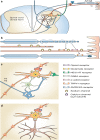Challenges in translational drug research in neuropathic and inflammatory pain: the prerequisites for a new paradigm
- PMID: 28894907
- PMCID: PMC5599481
- DOI: 10.1007/s00228-017-2301-8
Challenges in translational drug research in neuropathic and inflammatory pain: the prerequisites for a new paradigm
Abstract
Aim: Despite an improved understanding of the molecular mechanisms of nociception, existing analgesic drugs remain limited in terms of efficacy in chronic conditions, such as neuropathic pain. Here, we explore the underlying pathophysiological mechanisms of neuropathic and inflammatory pain and discuss the prerequisites and opportunities to reduce attrition and high-failure rate in the development of analgesic drugs.
Methods: A literature search was performed on preclinical and clinical publications aimed at the evaluation of analgesic compounds using MESH terms in PubMed. Publications were selected, which focused on (1) disease mechanisms leading to chronic/neuropathic pain and (2) druggable targets which are currently under evaluation in drug development. Attention was also given to the role of biomarkers and pharmacokinetic-pharmacodynamic modelling.
Results: Multiple mechanisms act concurrently to produce pain, which is a non-specific manifestation of underlying nociceptive pathways. Whereas these manifestations can be divided into neuropathic and inflammatory pain, it is now clear that inflammatory mechanisms are a common trigger for both types of pain. This has implications for drug development, as the assessment of drug effects in experimental models of neuropathic and chronic pain is driven by overt behavioural measures. By contrast, the use of mechanistic biomarkers in inflammatory pain has provided the pharmacological basis for dose selection and evaluation of non-steroidal anti-inflammatory drugs (NSAIDs).
Conclusion: A different paradigm is required for the identification of relevant targets and candidate molecules whereby pain is coupled to the cause of sensorial signal processing dysfunction rather than clinical symptoms. Biomarkers which enable the characterisation of drug binding and target activity are needed for a more robust dose rationale in early clinical development. Such an approach may be facilitated by quantitative clinical pharmacology and evolving technologies in brain imaging, allowing accurate assessment of target engagement, and prediction of treatment effects before embarking on large clinical trials.
Keywords: Analgesics; Chronic pain; Drug development; Hyperalgesia; Inflammatory pain; Neuropathic pain; PKPD modelling.
Conflict of interest statement
The authors declare that they have no conflict of interest.
Figures







Similar articles
-
Pharmacological Probes to Validate Biomarkers for Analgesic Drug Development.Int J Mol Sci. 2022 Jul 27;23(15):8295. doi: 10.3390/ijms23158295. Int J Mol Sci. 2022. PMID: 35955432 Free PMC article.
-
Research progress of mechanisms and drug therapy for neuropathic pain.Life Sci. 2017 Dec 1;190:68-77. doi: 10.1016/j.lfs.2017.09.033. Epub 2017 Sep 28. Life Sci. 2017. PMID: 28964813 Review.
-
Neuropathic low back pain in clinical practice.Eur J Pain. 2016 Jul;20(6):861-73. doi: 10.1002/ejp.838. Epub 2016 Mar 2. Eur J Pain. 2016. PMID: 26935254 Free PMC article. Review.
-
PPARs and pain.Br J Pharmacol. 2019 May;176(10):1421-1442. doi: 10.1111/bph.14339. Epub 2018 Jun 3. Br J Pharmacol. 2019. PMID: 29679493 Free PMC article. Review.
-
Mechanistic, translational, quantitative pain assessment tools in profiling of pain patients and for development of new analgesic compounds.Scand J Pain. 2013 Oct 1;4(4):226-230. doi: 10.1016/j.sjpain.2013.07.026. Scand J Pain. 2013. PMID: 29913625
Cited by
-
Adaptation of robust Z' factor for assay quality assessment in microelectrode array based screening using adult dorsal root ganglion neurons.J Neurosci Methods. 2020 Jun 1;339:108699. doi: 10.1016/j.jneumeth.2020.108699. Epub 2020 Mar 26. J Neurosci Methods. 2020. PMID: 32224158 Free PMC article.
-
Annexin-1 Mimetic Peptide Ac2-26 Suppresses Inflammatory Mediators in LPS-Induced Astrocytes and Ameliorates Pain Hypersensitivity in a Rat Model of Inflammatory Pain.Cell Mol Neurobiol. 2020 May;40(4):569-585. doi: 10.1007/s10571-019-00755-8. Epub 2019 Nov 13. Cell Mol Neurobiol. 2020. PMID: 31722050 Free PMC article.
-
The Role of the Brain-Derived Neurotrophic Factor in Chronic Pain: Links to Central Sensitization and Neuroinflammation.Biomolecules. 2024 Jan 5;14(1):71. doi: 10.3390/biom14010071. Biomolecules. 2024. PMID: 38254671 Free PMC article. Review.
-
Individuals with both higher recent negative affect and physical pain have higher levels of C-reactive protein.Brain Behav Immun Health. 2022 Feb 15;21:100431. doi: 10.1016/j.bbih.2022.100431. eCollection 2022 May. Brain Behav Immun Health. 2022. PMID: 35243409 Free PMC article.
-
Signaling via the FLP-14/FRPR-19 neuropeptide pathway sustains nociceptive response to repeated noxious stimuli in C. elegans.PLoS Genet. 2021 Nov 8;17(11):e1009880. doi: 10.1371/journal.pgen.1009880. eCollection 2021 Nov. PLoS Genet. 2021. PMID: 34748554 Free PMC article.
References
Publication types
MeSH terms
Substances
LinkOut - more resources
Full Text Sources
Other Literature Sources
Medical

